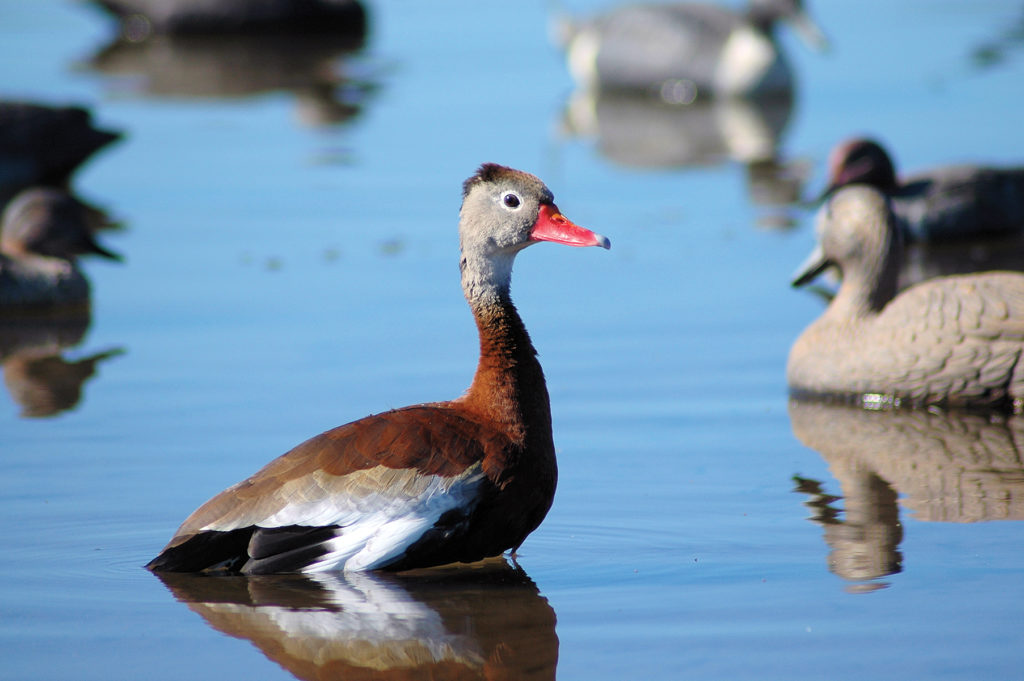Unusual game birds becoming more common in U.S.
By John Felsher

Photo by John N. Felsher
Sounding like squeaky wheels needing grease, about 50 noisy long-necked birds with prominent white wing splotches circled overhead as we crouched in our blind. Responding to our whistling calls, the birds began to settle into the waters just outside our decoys. Even some veteran waterfowlers looking at that same flock might whisper, “What in the world is that? Is it legal?”
Common south of the Rio Grande, black-bellied and fulvous whistling ducks greatly expanded their breeding range northward and eastward in recent years. Now, many of them breed in the United States, including parts of Alabama. Large numbers live in eastern Texas, southern Louisiana and parts of Florida. They occasionally visit California, Arizona, Georgia, South Carolina, Missouri, Tennessee and even stray as far north as Quebec, Canada.
“Whistling ducks are becoming more common in the United States,” explains Seth Maddox, the Alabama Department of Conservation & Natural Resources top migratory bird biologist. “They’ve been expanding their range for several years. In Alabama, whistling ducks are only found in the marshes along the coast. They typically hang around rice agriculture and we just don’t have a lot of that in Alabama.”
Formerly known as tree ducks, whistling ducks look like no other North American waterfowl. Well adapted for perching on branches, both species can land in trees and often congregate in woody backwaters. They also thrive in marshes, rice fields and coastal prairies. Highly gregarious, the birds may become quite numerous in local areas and commonly gather in large flocks.
“Both species look similar,” Maddox advises. “They are a little smaller than a mallard, but bigger than most other ducks. They act more like geese. A black-bellied whistling duck is more likely to go in trees than a fulvous. Fulvous are a more caramel color with a little bit of black on them. They have a light gray or blueish bill and legs.”
With elongated necks and their long legs trailing behind them, whistlers look more like an ibis than a duck. They make strong, slow wing beats unlike the frenzied flapping of other ducks. They also frequently land on dry ground like geese and stand straight upright with their long necks extended.
Hunters can add them to their bags during the duck season, but they might vanish before the season even begins. Locally common in some areas during the September teal season when they are not legal to hunt in Alabama, most whistlers disappear before the general duck season opens in Alabama. When cold weather hits, whistling ducks head south into Mexico, Central and South America. However, during warmer years, some might stay around long enough to give Alabama waterfowlers an opportunity at a different species.
“Usually, we see whistling ducks in Alabama during the summer breeding season,” Maddox advises. “Throughout the year, they gather in large flocks, maybe more than a thousand birds, but during the spring and summer, they’re secluded. A pair breaks off from that large group and try to find their own little territory to build a nest and raise their young. As the weather starts to cool, most whistling ducks migrate farther south to spend the winter. They don’t tolerate cold very well.”
Whistling ducks feed mainly on agricultural crops, particularly rice. They also prefer seeds and grasses, but may eat aquatic vegetation, insects, snails and other invertebrates. Because of their fondness for crops, they often hang around grain elevators, agricultural fields and even frequent golf courses or other suburban environs. Someone spotting a flock of whistlers in an agricultural field might stop to ask the farmer for permission to hunt the birds eating up all of his or her profits.
As duck hunting becomes tougher across Alabama, most waterfowlers would welcome an increasing whistler population expanding its range. These flavorsome birds make an excellent, tasty and welcome addition to a daily bag for any duck hunter lucky enough to spot them during the season. Perhaps soon, Alabama waterfowlers will no longer ask, “What’s that?”
The Alabama duck season opens Nov. 27-28 and again from Dec. 5 through Jan. 31, 2021. Sportsmen lucky enough to spot one, or a thousand, of these odd game birds, can add them to their daily bag limit of six ducks, but limits vary for some species so check the regulations. For more on Alabama duck hunting, see www.outdooralabama.com/seasons-and-bag-limits/waterfowl-season.
John N. Felsher lives in Semmes, Ala. Contact him through Facebook.





